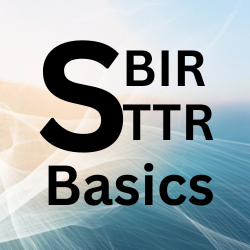Submitting your first SBIR (Small Business Innovation Research) or STTR (Small Business Technology Transfer) proposal can feel daunting. These highly competitive federal programs offer small businesses the chance to develop innovative technologies with funding from the U.S. government. However, a successful submission requires careful preparation, a clear strategy, and diligent attention to detail.
Whether you’re a startup entrepreneur or a seasoned business owner, here are essential things to do before you hit “submit” on your first SBIR or STTR proposal:
Understand the Funding Opportunity
The first step in preparing a strong proposal is to thoroughly understand the funding opportunity (FOA) or request for proposals (RFP). The SBIR and STTR programs span multiple agencies—such as the Department of Defense (DoD), National Institutes of Health (NIH), National Science Foundation (NSF), and others. Each agency has its unique goals and priorities, so take the time to:
- Review the agency’s mission and how it aligns with your business.
- Study past awardees and learn from their successes.
- Understand each agency’s proposal requirements, deadlines, and specific submission processes.
This research will inform how you frame your project and increase the chances of your proposal standing out in the selection process.
Align Your Proposal and Innovation with Agency Needs
Demonstrating how your innovation solves a problem or meets a need that the funding agency focuses on is a critical factor in the success of any SBIR or STTR proposal. Here’s how to ensure alignment:
- Analyze the agency’s specific needs outlined in the FOA or RFP.
- Identify how your product or solution fits into their research priorities.
- Conduct interviews or discussions with program managers or experts to clarify any areas of alignment and better understand the agency’s goals.
The more clearly you can show that your innovation addresses the agency’s core objectives, the more likely you are to garner attention from decision-makers.
Build a Strong Proposal Team
The strength of your team can significantly impact your proposal’s success. Agencies want to fund small businesses with the technical expertise and operational capacity to carry out their projects. Before submitting your proposal:
- Evaluate the skills needed to execute your project, from technical development to market analysis.
- Consider partnering with research institutions or universities if you apply for an STTR. The STTR program encourages explicit collaboration between small businesses and academic institutions.
- Seek experts in relevant fields who can complement your skills and offer credibility to your proposal.
A solid, experienced team can make a significant difference in how your proposal is received.
Develop a Clear, Concise Technical Approach
The technical approach is the heart of your SBIR or STTR proposal. This section outlines how you will solve the problem, the methodology you will use, and the steps you will take to bring your innovation to life. Before drafting your technical approach:
- Clearly define the problem you’re solving.
- Break down the project into phases, showing clear milestones and deliverables.
- Provide a detailed timeline of activities and their respective costs.
- Make sure the language is accessible but precise, as reviewers may not be experts in your specific field.
A well-organized, well-structured technical approach will provide confidence that your business can execute the proposed work.
Prepare a Robust Commercialization Plan
Federal agencies want to see that your innovation has the potential for long-term success. A robust commercialization plan is essential to show how you intend to bring your product to market. In your plan:
- Clearly define your target market, including size, needs, and current competitors.
- Lay out your sales and marketing strategy.
- Discuss potential partners, customers, or investors.
- Include timelines and benchmarks for bringing your product from development to commercialization.
Remember, your goal is to convince reviewers that your business can turn the innovation into a viable, sustainable product in the market.
Budget Wisely and Justify Expenses
Your proposal’s budget is more than just numbers; it needs to be a realistic representation of the costs associated with bringing your innovation to fruition. Carefully plan each budget item, ensuring the requested funds align with the project scope and needs. Consider:
- Direct costs, such as labor, materials, and equipment.
- Indirect costs like overhead and administrative expenses.
- Any additional costs for external partners or consultants.
Make sure to provide detailed justifications for each budget item to help reviewers understand why the funding is necessary.
Follow the Proposal Submission Guidelines to the Letter
Every SBIR and STTR proposal must follow strict formatting and submission guidelines. Minor deviations from these instructions could lead to disqualification or an automatic rejection. Before submitting, double-check that you:
- Adhere to word or page limits.
- Use the required font size, margins, and formatting.
- Include all required documents (such as letters of support, bios, or certifications).
- Submit your proposal by the deadline—late submissions are generally not considered.
Remember that small details can make a big difference in the outcome of your submission.
Seek Feedback from Experts to Improve Your Proposal
One of the best ways to improve your proposal is by having experts review it before you submit. Reach out to:
- Mentors or advisors with experience in SBIR/STTR applications.
- Consultants or professionals who specialize in proposal writing.
- People from your network with expertise in commercialization or the technical aspects of your innovation.
Feedback from those with experience can help identify weaknesses, improve clarity, and ensure your proposal is as compelling as possible.
Prepare for Post-Submission Activities
Once your proposal is submitted, the work doesn’t stop there. Be prepared for follow-up activities, such as:
- Responding to questions or requests for additional information from the agency.
- Participating in interviews or presentations if your proposal advances.
- Continuing to refine your project plan based on feedback from the agency.
Staying flexible and open to revisions is key to successfully navigating the post-submission phase.
Don’t Be Discouraged by Rejection
Finally, while rejection is always possible in competitive programs like SBIR and STTR, don’t be discouraged. Use feedback from the reviewers to improve your proposal and try again. Many successful companies have faced rejection but used it as an opportunity to refine their ideas and approaches.
Final Thoughts
Submitting your first SBIR or STTR proposal is a significant milestone for your business. By preparing carefully, aligning your innovation with agency needs, assembling a strong team, and following all guidelines, you can increase your chances of success. Remember, each submission is a learning experience that brings you one step closer to securing valuable funding and advancing your innovation.
With persistence, a clear strategy, and a commitment to excellence, you’ll be well on your way to a successful submission. Good luck!

